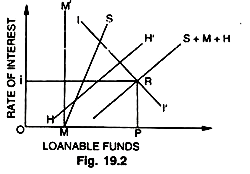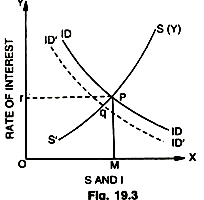Here we detail about the eight criticisms of classical and neo-classical theories of interest by Keynes.
1. Special Theory:
Keynes criticized the traditional theory of the rate of interest on the ground that it does not take into consideration the changes in the level of income and assumed it to be constant (given).
He called the classical theory of interest as a special theory of interest because it is based on a fixed level of income corresponding to a fixed level of employment (full employment). By ignoring all important changes in the level of income, traditional theory viewed the rate of interest as the factor which brings about equality between the demand for and supply of investible funds (as shown in Fig. 19.2).
2. Rate of Interest not an Equilibrating Mechanism:
Keynes asserts that the equality between saving and investment is brought about by changes in the level of income and not by the rate of interest alone. Keynes accepts the classical contention of equality between saving and investment but attributes this equality to the change in the level of income rather than to the rate of interest.
ADVERTISEMENTS:
Keynes finds no difficulty in agreeing with the classical contention that if full employment level of income is assumed to be given, the current market rate of interest will be at the point of intersection of investment demand schedule and the schedule of savings (as in the Fig. 19.3). Keynes, however, does not agree with the classical theory, when it goes a step further and assumes that, if the investment demand schedule (ID) shifts from ID to ID intersection of the new investment curve (ID) with the old supply curve (SY) will give the new rate of interest at q.
The classicals error lies in believing that investment can change without causing a change in income. A fall in the MEC causes the investment to fall to ID ‘leading to a decline in income, out of which less will be saved. Thus, it is difficult to believe that ID schedule can shift without causing a shift in the saving schedule SY. Since saving schedule also changes, we can neither determine the rate of interest nor the volume of saving and investment. “There are not enough data in the classical scheme to yield this information.”
3. Indeterminate:
Keynes attacked the classical theory on the ground that it is indeterminate. According to the classical theory, the rate of interest is determined by the intersection of demand for and supply of capital schedules. But according to Keynes, saving schedule will change with a change in the level of income. As income rises, the schedule will shift to the right.
ADVERTISEMENTS:
Thus, we cannot find the rate of interest unless we already know the level of income and we cannot find the level of income unless we know the rate of interest, as a lower rate of interest will mean larger investment and a higher level of income. The classical position, therefore, is quite confusing and indeterminate, as it offers no solution.
4. Full Employment of Resources:
Keynes also objects to the basic assumption (on which the special classical theory of interest is based) that resources are fully employed. It is this postulate that, according to him, lacks reality in the contemporary world. According to Keynes, as long as there are unemployed resources in the economy, there is no sense in paying the people to abstain from consumption, so that more resources could be employed for the production of capital goods (investment).
The obvious way would be to put idle resources to work rather than to withdraw resources already employed. Thus, something other than the theory of ‘waiting’ or ‘abstinence’ or ‘time preference’ is needed to explain the emergence of interest. According to Keynes, interest being a purely monetary phenomenon, is a payment for the use of money and is determined by the demand for and supply of money.
5. Role of Money:
ADVERTISEMENTS:
Moreover, according to Keynes, the classical theory of interest completely ignores the significant part played by the quantity of money, created money and bank credit in the determination of the rate of interest. Though less important in 18th and 19th centuries, the role of banking and created money in the determination of the rate of interest has increased tremendously in modern times. Money is no more neutral and does not act merely as a veil as assumed by the classicals. To Keynes, money plays a very significant active role in determining and influencing the interest rate and hence investment and employment.
6. Savings and Investment are not Always Interest-Elastic:
Further, in the classical theory, both investment and savings are shown to be interest-elastic (sensitive to the changes in the rate of interest). However, modern development has shown that they are not always interest-elastic.
In fact, the relationship between the two is rather indirect and weak, if any. Investment depends upon future expectations and the marginal efficiency of capital; as such a high rate of interest is perfectly compatible with high investment. Similarly, savings are but rarely interest-elastic. In poor economies, at low income levels, no rise in the rate of interest will generate more savings. The level of income has greater influence on savings than the rate of interest.
7. Chance Equality of Natural and Market Rates of Interest:
Classical held the view that any discrepancy between the natural and the market rates of interest was purely accidental and could not exist for a long time, but Wicksell, Keynes and other monetary experts held the view that the divergence between the two was not accidental or per chance, but it was due to the monetary influences like the creation and destruction of credit by banks. When they create money, the total supply of loanable funds increases and the market rate of interest falls below the natural rate and vice-versa. It is, therefore, clear that money in a modern economy does not play a neutral role. Hence, classicals were clearly wrong in excluding the influences of monetary factors on the rate of interest.
8. Importance of MEC:
Again, the classical theory ignores the importance of MEC and is not successful in its attempt to show the relationship between the rate of interest and the marginal efficiency of capital. The output of new investment will be pushed up to the point at which the MEC of capital becomes equal to the rate of interest. What the schedule of the MEC tells us is not, what the rate of interest is but the point to which the output of new investment will be pushed, given the rate of interest.
Thus, we find that classical theory of the rate of interest was not acceptable to Keynes both in its old and modified (neo-classical loanable funds) forms, because it tacitly assumed that income is given at the level corresponding to full employment. In other words, it assumed that the monetary policy is such as to maintain the rate of interest which is compatible with full employment.
He, therefore, called it a special theory incapable of dealing with the general case where employment is liable to fluctuate. The ineffectiveness of the classical monetary policy in a severe depression was demonstrated by the Keynesian analysis and by the actual experience of the depression of the early 1930s, when the thirst of the owners of money for liquidity made it impossible for the central bank to increase the supply of funds and to revive business activity, even at somewhat lower interest rates in the absence of prospective profits (i.e., favourable marginal efficiency of capital). The divergence of views between Keynes and the classical school boils down once again to the differences between the logic of an economics of full employment and logic of an economics of less than full employment.

